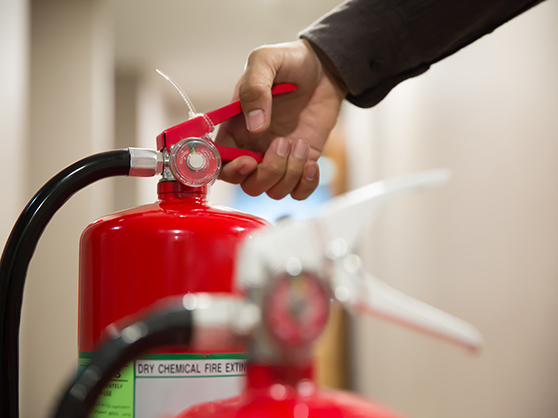A portable fire extinguisher can save lives and property by putting out a small fire or containing it until the fire department arrives; but portable extinguishers have limitations. Because fire grows and spreads so rapidly, the #1 priority for residents is to get out safely. Here is what you need to know about choosing and using fire extinguishers!
Remember to Check Your Fire Extinguisher for:
- Easy access in an emergency- be sure nothing is blocking or limiting your ability to reach it.
- The recommended pressure level- many extinguishers have gauges that show when pressure is too high or too low.
- Working parts- make sure the can, hoses and nozzles aren’t damaged, dented, or rusted.
- Cleanliness- remove any dust, oil, or grease that might be on the outside of the extinguisher.
- Guidelines and instructions- some extinguishers need to be shaken monthly, others need to be pressure tested every few years.
When to Use a Fire Extinguisher
Fire extinguishers can be helpful on a small fire. Below is a checklist to help you prepare to use a fire extinguisher.
- Have I alerted others in the building that there’s a fire?
- Has someone called the fire department?
- Am I physically able to use a fire extinguisher?
- Is the fire small and contained in a single object (like a pan or a wastebasket)?
- Am I safe from the fire’s toxic smoke?
- Do I have a clear escape route?
Use a fire extinguisher when all of these questions are answered “yes.” If you’re unsure about whether or not it’s safe to use a fire extinguisher, and for all other situations, alert others, leave the building, and call 911 from a mobile or neighbor’s phone. It is not recommended that children use fire extinguishers.

More Fire Extinguisher Tips
- For the home, select a multi-purpose extinguisher (can be used on all types of home fires) that is large enough to put out a small fire, but not so heavy as to be difficult to handle.
- Choose a fire extinguisher that carries the label of an independent testing laboratory.
- Read the instructions that come with the fire extinguisher and become familiar with its parts and operation before a fire breaks out. Local fire departments or fire equipment distributors often offer hands-on fire extinguisher trainings.
- Install fire extinguishers close to an exit and keep your back to a clear exit when you use the device so you can make an easy escape if the fire cannot be controlled. If the room fills with smoke, leave immediately.
How to Use a Fire Extinguisher
When operating a fire extinguisher, tell remember the word PASS.
- Pull the pin. Hold the extinguisher with the nozzle pointing away from you and release the locking mechanism.
- Aim low. Point the extinguisher at the base of the fire.
- Squeeze the lever slowly and evenly.
- Sweep the nozzle from side-to-side.